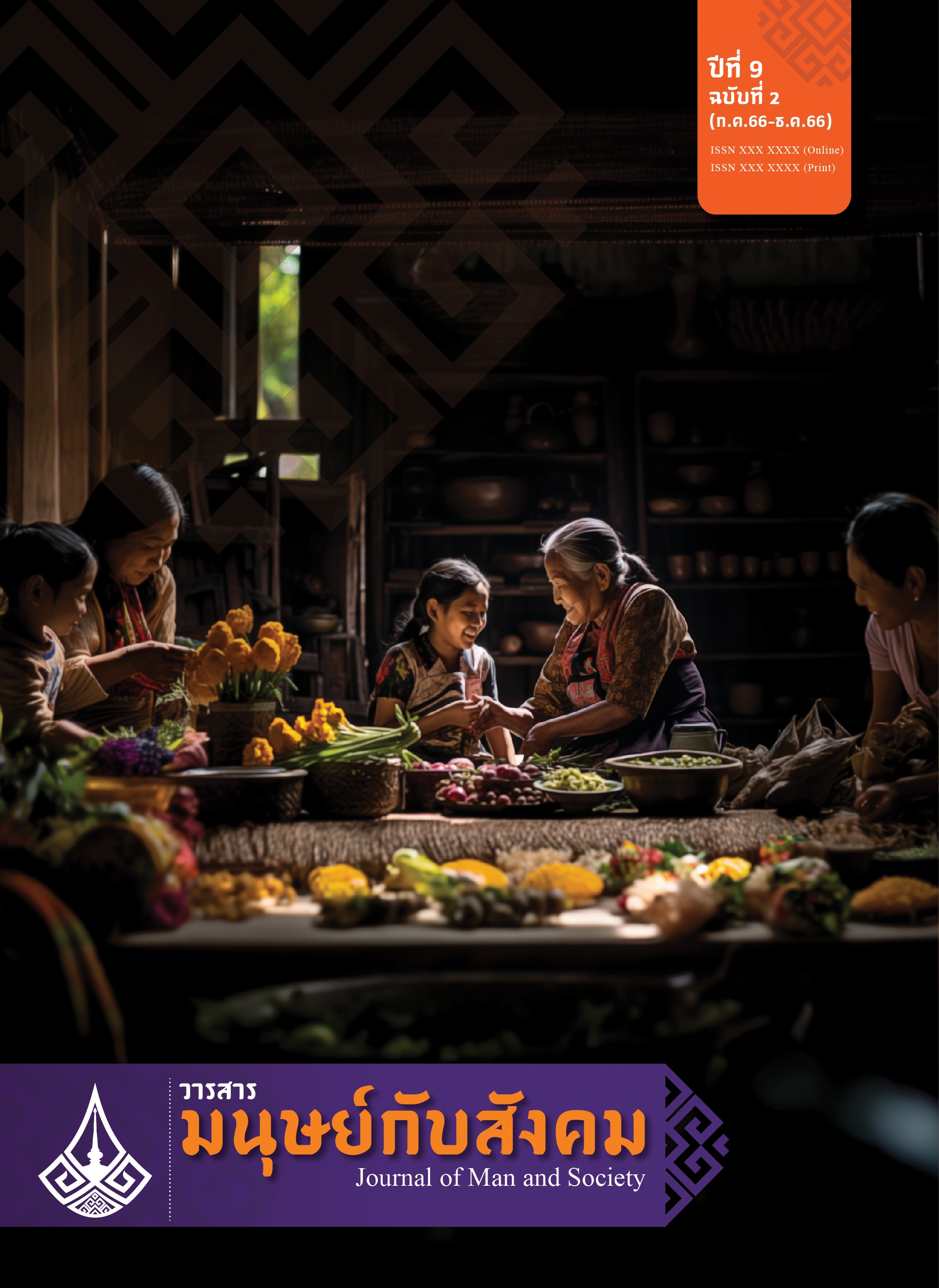Polysemy of ‘live’ in Lao: A Cognitive Semantic Study
Main Article Content
Abstract
The word /juu33/ or ‘to live’ is another word with many meanings in the Lao language. Using the cognitive semantic approach as a theoretical framework, the purposes of this study are 1) to subcategorize the meanings of /juu33/ in Lao and 2) to investigate the processes for semantic extension of the meaning of /juu33/. Data were collected from short texts in Lao textbooks and Lao Corpus. The findings indicate that the prototypical meaning of /juu33/ has been extended into seven meanings. Four lexical meanings include ‘to live somewhere’, ‘to live’, ‘ to be somewhere’ and ‘ to be still’. Three grammatical meanings are ‘to be somewhere’, ‘to be going on’, and ‘to be certain’. The semantic extension of the prototypical meaning of /juu33/ involves three cognitive processes: metaphor, metonymy, and subjectification.
Article Details

This work is licensed under a Creative Commons Attribution-NonCommercial-NoDerivatives 4.0 International License.
เนื้อหาและข้อมูลที่ตีพิมพ์ลงในวารสารมนุษย์กับสังคม ถือเป็นข้อคิดเห็นและความรับผิดชอบโดยตรงของผู้เขียนซึ่งกองบรรณาธิการวารสารไม่จำเป็นต้องเห็นด้วยหรือร่วมรับผิดชอบใดๆ
บทความ ข้อมูล เนื้อหา รูปภาพ ฯลฯ ที่ได้รับการตีพิมพ์ในวารสารมนุษย์กับสังคม ถือเป็นลิขสิทธิ์ของวารสาร หากบุคคลหรือหน่วยงานใดต้องการนำทั้งหมดหรือส่วนหนึ่งส่วนใดไปเผยแพร่ต่อต้องอ้างอิงวาสาร
References
กาจบัณฑิต วงษ์ศรี. (2547). เครือข่ายความหมายของคำว่า ‘ออก’ ในภาษาไทย: การศึกษาแนวอรรถศาสตร์ปริชาน. [วิทยานิพนธ์อักษรศาสตรมหาบัณฑิต, จุฬาลงกรณ์มหาวิทยาลัย]. Chulalongkorn University Intellectual
Repository (CUIR). https://cuir.car.chula.ac.th/bitstream/123456789/5110/1/katbandit.pdf
กิ่งกาญจน์ เทพกาญจนา. (2549). หน่วยสร้างกริยาเรียงต้นแบบในภาษาไทย. ใน หน่วยสร้างที่มีข้อขัดแย้งในไวยากรณ์ไทย. อมรา ประสิทธิ์รัฐสินธุ์. (บรรณาธิการ). โรงพิมพ์แห่งจุฬาลงกรณ์มหาวิทยาลัย.
จิรัชย์ หิรัญรัศ. (2550). การศึกษาความหมายของคำว่า ‘เอา’ ในภาษาไทย. [วิทยานิพนธ์อักษรศาสตรมหาบัณฑิต, จุฬาลงกรณ์มหาวิทยาลัย]. Chulalongkorn University Intellectual
Repository (CUIR). http://cuir.car.chula.ac.th/handle/123456789/52483.
นันทนา วงษ์ไทย. (2562). อรรถศาสตร์ปริชานเบื้องต้น. บริษัทเวิร์คออลพริ้นท์จำกัด.
ปิยะวดี คำสุวรรณ, คเชนทร์ ตัญศิริ และอุมาภรณ์ สังขมาน. (2562). การศึกษาคำว่า ตาม ในภาษาไทย. วารสารวรรณวิทัศน์, 19(2), 179-207.
พิชชากร ต้นวงศ์, คเชนทร์ ตัญศิริ และมุกข์ดา สุขธาราจาร. (2562). คุณสมบัติทางวากยสัมพันธ์และอรรถศาสตร์ของคำกริยาพื้นฐาน เปิด ในภาษาไทยที่ปรากฏร่วมกับศัพท์เฉพาะทาง: การศึกษาตามแนวอรรถศาสตร์ปริชานแบบอิงฐานข้อมูล. วารสารวัจนะ, 7(2), 39-58.
ราชบัณฑิตยสภา. (2553). พจนานุกรมศัพท์ภาษาศาสตร์ (ภาษาศาสตร์ทั่วไป) ฉบับราชบัณฑิตยสภา. สำนักงานราชบัณฑิตยสภา.
ราชบัณฑิตยสภา. (2560). พจนานุกรมศัพท์ภาษาศาสตร์ (ภาษาศาสตร์ทั่วไป) ฉบับราชบัณฑิตยสภา. สำนักงานราชบัณฑิตยสภา.
สถาบันค้นคว้าวิทยาศาสตร์การศึกษา กระทรวงศึกษาธิการและกีฬา. (2011). แบบเรียนภาษาลาว ชั้นประถมปีที่ 3. กระทรวงศึกษาธิการและกีฬา.
สถาบันค้นคว้าวิทยาศาสตร์การศึกษา กระทรวงศึกษาธิการและกีฬา. (2013). แบบเรียนภาษาลาว ชั้นประถมปีที่ 2. กระทรวงศึกษาธิการและกีฬา.
สถาบันค้นคว้าวิทยาศาสตร์การศึกษา กระทรวงศึกษาธิการและกีฬา. (2015). แบบเรียนภาษาลาว ชั้นประถมปีที่ 1. กระทรวงศึกษาธิการและกีฬา.
โสรัจ เรืองมณี. (2553). ความหมายของคำว่า được ‘ได้’ ในภาษาเวียดนาม: การศึกษาตามแนวภาษาศาสตร์ปริชาน. [วิทยานิพนธ์อักษรศาสตรดุษฏีบัณฑิต, จุฬาลงกรณ์มหาวิทยาลัย]. Chulalongkorn University
Intellectual Repository (CUIR). https://cuir.car.chula.ac.th/handle/123456789/19362
อมรา ประสิทธิ์รัฐสินธุ์. (2553). ชนิดของคำในภาษาไทย: การวิเคราะห์ทางวากยสัมพันธ์. สำนักพิมพ์เอเอ๊สพี.
Enfield, N. J. (2007). A Grammar of Lao. Mouton de Gruyter.
Riemer, N. (2005). The Semantic of Polysemy: Reading Meaning in English and Warlpiri. Mouton de Gruyter.
Saeed, I. J. (2000). Semantics. Blackwell Publishers Ltd.
Traugott E. C. (1989). On the rise of epistemic meanings in English: an example of subjectification in semantic change. Language, 65, (1), 31-55.
Tyler, A. & Evans, C. (2003). The Semantic of English Preposition: Spatial Scenes, Embodied Meaning and Cognition. Cambridge University Press.
Wright, P. S. (1994). A Lao Grammar for Language Learners. วารสารภาษาและภาษาศาสตร์, 13 (พิเศษ), 1-95.
การสัมภาษณ์
สมพาวัน แก้วบุดดา. (การสื่อสารส่วนบุคคล, 16 มีนาคม 2563). อาจารย์ประจำคณะมนุษยศาสตร์และสังคมศาสตร์ มหาวิทยาลัยมหาสารคาม ตำบลขามเรียง อำเภอกันทรวิชัย จังหวัดมหาสารคาม.
สมเพ็ด แสงจัน. (การสื่อสารส่วนบุคคล, 16 มีนาคม 2563). อาจารย์ประจำคณะมนุษยศาสตร์และสังคมศาสตร์ มหาวิทยาลัยมหาสารคาม ตำบลขามเรียง อำเภอกันทรวิชัย จังหวัดมหาสารคาม.


